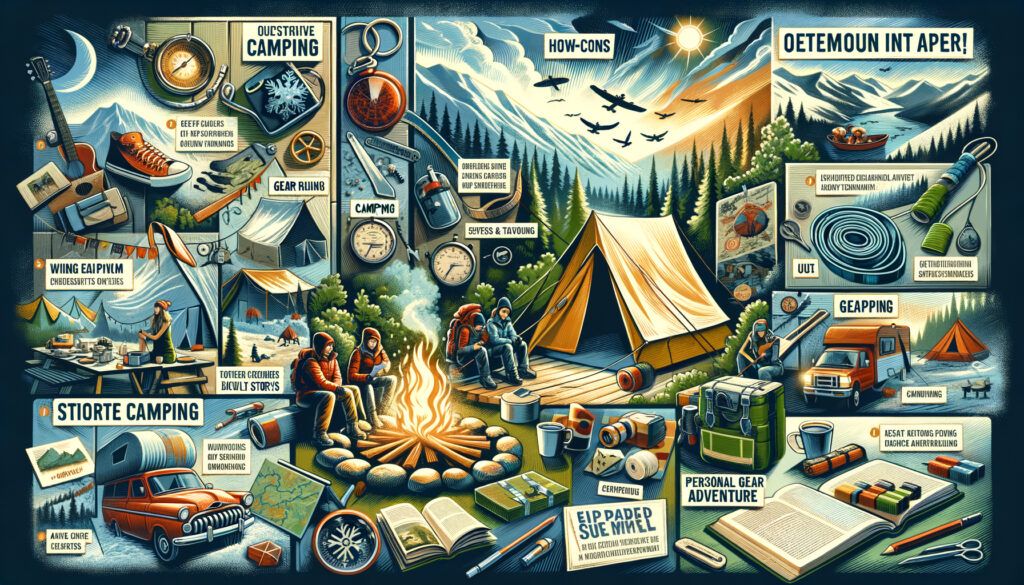
Affiliate marketing has been a big buzzword in the digital world, but what’s the deal with it, especially in the camping niche? It’s simple: you promote products or services from other companies, and when your readers click on your affiliate links and make a purchase, you earn a commission. Pretty neat, right?
Now, let’s talk camping. The outdoor industry is booming. People are swapping their screen time for adventure time more than ever. From social media hype to a genuine love for nature, camping is hot, hot, hot. This is why it fits perfectly with affiliate marketing.
Signing up For some great affiliate programs lets you recommend the coolest camping gear and gadgets to your audience, helping them make smart, informed choices. If you’ve spent nights under the stars or have a knack for outdoor gear, you can turn your passion into profits. Think of it as sharing your joy for camping and getting paid for it. Win-win! Right!
SO FULL DISCLOSURE: This website dose contain affiliate links. They can lead you to other blogs as well as a sign up for an affiliate marketing platform if your are interested in building a online income this blog, will help you do just that and there is no additional cost to you to explore these links SO ENJOY THE BLOG!!
why is camping ideal for affiliate marketing?
It’s specific enough to cater to a passionate, engaged audience but broad enough to offer a variety of products and services. From tents to portable stoves to survival kits, the possibilities are vast. The key is authenticity. Your readers can tell if you’re genuinely excited about the gear you’re recommending – and trust me, that sincerity makes all the difference.
Overall, camping affiliate marketing is about connecting your love for the outdoors with savvy business tactics. It’s about building trust with your audience by providing them with valuable information and top-notch gear they’re interested in. So, if you’re looking to combine your blogging skills with your passion for camping, there’s no better time to get started!
Building a Successful Camping Blog

Starting a camping blog might seem daunting, but with a bit of guidance, you’ll be up and running in no time. First, choose a catchy but relevant blog name – something that reflects your camping passion and personal flair. You’ll want your audience to connect with your brand right from the get-go. Once you’ve nailed down the name, it’s time to set up your blog on a platform like WordPress witch wealthy Affiliates offers with so much more; it’s user-friendly and has loads of plugins to make your life easier.
A killer design is crucial. It doesn’t need to be super fancy, but it should be clean, easy to navigate, and visually appealing. Think about your audience – they want to find great content fast without wading through clutter. High-quality photos and videos can make a huge impact, especially in the camping niche where visuals can really bring your adventures to life.
Content is king,
so focus on creating valuable, engaging content that speaks to your readers’ interests. Share your personal experiences, tips, and product reviews. Authenticity is key here. You want your readers to feel like they’re on the journey with you. Remember to use keywords that campers might search for – this helps your blog show up in search engine results.
SEO might sound technical, but it’s all about making your blog more visible online. Use relevant keywords in your titles, headings, and throughout your content. Don’t forget to write meta descriptions and use alt text for your images. These elements help search engines understand what your blog is about, making it easier for people to find.
Promoting your blog is just as important as writing it.
Share your posts on social media, join camping forums, and engage with your audience. Building a community around your blog takes time, but it’s worth the effort. Engage with your readers by replying to comments and asking for their input. They’ll appreciate the personal touch.
Lastly, keep learning and stay curious. Blogging trends and SEO practices change, so stay updated. There are countless resources online, from blogs to webinars, that can help you improve your blogging game. Consistent effort and a genuine love for what you’re doing will shine through in your blog, setting you up for success.
Choosing the Right Affiliate Programs

Choosing the right affiliate programs can make or break your camping blog’s revenue streams. Start by looking at programs that offer high-quality, relevant products. Don’t just pick anything with a high commission; your reputation with your readers is on the line here. They trust your recommendations, so make sure you’re promoting items that you genuinely believe in and have tested yourself if possible.
Check for affiliate programs connected to established brands that outdoor enthusiasts recognize and love. Companies like REI, Patagonia, and The North Face typically have solid affiliate programs. When you link to well-known brands, your audience feels more confident making a purchase. Also, consider niche-specific programs for cool gadgets and gear that might not be mainstream but are beloved in the camping community.
Pay attention to the commission rates and cookie duration.
A higher commission rate might seem enticing, but a longer cookie duration can sometimes be more beneficial. If a program offers a 30-day cookie compared to a 7-day one, you have a better chance of earning a commission if someone decides to purchase later rather than immediately.
Read the terms and conditions of each program carefully. Some programs might have restrictions on how you can promote their products. For example, they may have rules about using their images or might prohibit certain types of social media advertising.
Balance is key.
Mix high-commission items with lower-priced essentials that your audience needs and frequently buys. This strategy ensures you provide a comprehensive guide to everything a camping trip might require, from big-ticket items like tents to smaller essentials like portable water filters.
Lastly, keep experimenting. Just because one program works for someone else doesn’t mean it’s the best fit for you. Track your performance, see what your audience responds to, and adjust your strategy accordingly. Flexibility and responsiveness can lead to optimizing your affiliate marketing efforts.
Creating Compelling Content That Converts

Content is the heartbeat of your blog, and when it comes to camping, there’s a ton you can explore. Start by thinking about the types of content your readers would find useful and engaging.
- Gear reviews,
- How-to guides,
- Detailed gear lists,
- Personal adventure stories
are always hits. Go beyond basic descriptions; dive into the details that only someone with firsthand experience would know.
Personal anecdotes are gold. Share your and your readers’ stories; they humanize your blog and create a connection. When reviewing products, include instances of how you used them in the field. Did that new tent withstand a crazy storm? Did your portable stove save the day when your campfire plans went awry? These insights make your content relatable and trustworthy.
SEO , shouldn’t be an afterthought when creating content. Use relevant keywords naturally throughout your posts. Think about what someone might type into Google – ‘best lightweight tents for backpacking‘ or ‘how to start a campfire without matches.’ These phrases should pop up in your headers and content, without sounding forced. Tools like Jaaxy Keyword Planner can help identify popular search terms in your niche.
Engage your readers by using a conversational tone. Ask questions, encourage comments, and invite them to share their own tips and experiences. Creating a two-way conversation builds community and loyalty, turning occasional visitors into regular readers.
Incorporate high-quality visuals. Clear, well-composed photos and engaging videos can significantly enhance your content. Showing your gear in action helps readers visualize their own experiences and builds excitement. Use alt text for your images to improve SEO and make your content accessible to everyone.
Don’t forget to include clear, compelling calls to action. Whether it’s encouraging readers to click on affiliate links, sign up for newsletters, or leave comments, make sure your requests are direct and straightforward. ‘Check out this awesome camping stove’ linked to your affiliate partner looks more natural than a generic ‘click here.’ Your readers will appreciate the guidance.
Monetization Strategies for Camping Blogs

Effectively using affiliate links within your posts is an art. You don’t just want to scatter links everywhere and hope for the best. Instead, be strategic. Integrate affiliate links naturally into your content where they make the most sense. If you’re writing a review of a new hiking backpack, that’s the perfect place for links to purchase the backpack—and maybe even related gear like water bottles or camping utensils. Always disclose that your content contains affiliate links to maintain transparency with your readers.
Diversifying your income streams is another critical strategy.
Relying solely on affiliate marketing can be risky, so think about incorporating sponsored posts, banner ads, or even selling your own products. If you’ve established yourself as an expert, companies may be willing to pay for a featured spot on your blog. Sponsored posts can be a win, but make sure they align with your existing content and values. Your readers will notice if something feels off or out of place.
Creating an e-book or guide around a specific camping topic can be a valuable resource for your readers and a solid source of income for you. Imagine writing a comprehensive guide on ‘Camping for Beginners’ or ‘The Ultimate Guide to Winter Camping.’ These can be sold directly through your blog, giving your audience detailed advice while adding to your income.
Ads can provide steady income, but they must be used wisely. Too many ads can clutter your blog and frustrate your readers. Choose ad networks that respect user experience, like Google AdSense. Keep an eye on how these ads impact your blog’s performance, and adjust as necessary to maintain a balance between monetization and a pleasant reading experience.
Look at case studies of successful camping blogs to see what works. Analyze their strategies, the types of content they produce, and how they position their affiliate links and other monetization methods. Learning from those who’ve successfully navigated this path can provide valuable insights and help you avoid common pitfalls. Adapt these strategies to fit your style and audience, rather than copying them flat out.
The key to successful monetization is keeping your audience’s needs at the forefront. If you’re meeting their needs with genuine, helpful, and engaging content, monetization will follow naturally. Your readers should never feel like you’re pushing products on them for the sake of commission. They should feel supported and informed, whether they’re purchasing through your affiliate links or not
Measuring Success and Scaling Your Blog

Tracking your progress is essential to understand what’s working and where you need to pivot. Keep an eye on key metrics like website traffic, click-through rates on your affiliate links, conversion rates, and reader engagement. Tools like Google Analytics can be your best friend here, offering insights into visitor behavior, page popularity, and more.
Analyzing these metrics helps you adjust your content and marketing strategies. If a particular type of post is driving more traffic, consider creating more of that content. If your click-through rates are high but conversions are low, reassess your affiliate links’ placement and the products you’re promoting. Maybe the products aren’t compelling enough, or the offers need to be better.
Reader feedback is another gold mine.
Comments, emails, and social media interactions can provide valuable insights into what your audience loves and what they’re missing. Encourage your readers to share their thoughts and experiences, and always be open to their suggestions. It’s this open dialogue that can set your blog apart.
Scaling your blog is about expanding your reach and influence. Collaborate with other camping bloggers, participate in guest posting, and attend industry events. Networking can open doors to new opportunities and audiences. Cross-promotions and collaborations often result in a win-win situation, exposing both parties to a broader audience.
Consider enhancing your content with media such as podcasts or videos. Exploring different content formats can make your blog more dynamic and reach people who prefer consuming content in various ways. Videos showcasing gear in action or podcast interviews with fellow camping enthusiasts can add a new dimension to your blog.
Continually invest in your learning and skills. The digital world is always evolving, so stay updated with the latest SEO practices, technology tools, and trends in the camping niche. Take online courses, participate in webinars, and read industry blogs. The more knowledgeable and skilled you become, the more value you can provide to your readers, which translates to increased trust and loyalty.
Thanks for stopping by i hope you enjoyed all the info? feel free to reach out if you have any question. for now ill leave you with these other blogs i wrote have a look take care.
- Understanding Affiliate Marketing Networks Before Starting
- Choosing The Right Affiliate Network For Your Business
- The Right Affiliate Programs To Join


Hi!
Great post! It’s impressive to see how successful bloggers have turned their passion for camping into profitable ventures through affiliate marketing. Your emphasis on authenticity and building trust with the audience really resonates—it’s clear that understanding and genuinely enjoying the products you’re promoting can make all the difference. The tips on content creation and SEO are particularly useful for anyone looking to start or improve their camping blog.
I found the section on choosing the right affiliate programs insightful, especially the balance between high-commission items and essentials that campers frequently need. It’s also encouraging to see how diversifying income streams, like creating e-books or adding sponsored posts, can enhance a blog’s revenue potential.
One thing I’m curious about is how long it typically takes for new bloggers in the camping niche to start seeing significant earnings from affiliate marketing. What kind of timeline and effort should one realistically expect before reaching a point of financial success?
– Scott
hey Scott
Thanks for the great comment, For your question : Well that all depends on the way you promote it. but with in 30 days you should see a good start anyways.
sorry i cant give you numbers as every person is different.
Camping is such a popular way of exploring the outdoors and can easily be done if you have a restricted budget for a holiday. So this is a great suggestion to build a blog around camping and monetizing it with affiliate marketing links.
You do mention that camping is quite a broad niche, so would it be advisable to narrow it down more, into something like camping for families? Or does one narrow it down in specific blog posts? Thank you.
Hi LineCowley
Thanks for the awesome comment, For your outstanding questions i’ll do my best to answer them for you.
Question 1
so would it be advisable to narrow it down more, into something like camping for families?
Absolutely, and that is a very interesting idea
Question 2
Does one narrow it down in specific blog posts?
I would think so ill try to build an extra blog this week ill call it Bigfoot camping for families
thanks again for reaching out i hope you have enjoyed the blog.